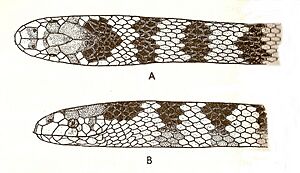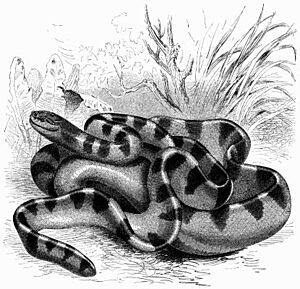Annulated sea snake facts for kids
Quick facts for kids Annulated sea snake |
|
|---|---|
 |
|
| Conservation status | |
| Scientific classification | |
| Genus: |
Hydrophis
|
| Species: |
cyanocinctus
|
| Synonyms | |
|
|
The annulated sea snake, also called the blue-banded sea snake, is a type of venomous sea snake. Its scientific name is Hydrophis cyanocinctus. It belongs to the Elapidae family, which includes many well-known venomous snakes. This snake lives in the ocean and is known for its unique banded patterns.
Contents
About the Annulated Sea Snake
What Does It Look Like?
The annulated sea snake has a head that is a normal size for its body. Its eyes are smaller than the distance from the eye to its mouth. The scales on its back are slightly overlapping. They can be rough or have small bumps. There are usually 39 to 45 rows of these scales around its body. The scales on its belly, called ventrals, are smooth or have small bumps. There are many of these scales, from 281 to 385.
The snake's body is long. Its head and body can reach about 1360 millimeters (about 53 inches). Its tail is shorter, around 140 millimeters (about 5.5 inches).
Its Colors and Patterns
This sea snake usually has a greenish-olive color on top. It has dark, blackish or olive bands that go across its body. These bands are widest on its back. Sometimes, these dark bands connect with a black stripe along its belly. Other times, the snake can be yellowish with a black stripe down its back. It might also have a few black bands on its neck.
Special Breathing System
In 2019, scientists discovered something amazing about this snake. It has a special system of blood vessels in its head. This system is called the Modified Cephalic Vascular Network (MCVN). It helps the snake's brain get extra oxygen when it is underwater for a long time. This is a great adaptation for a creature that lives in the ocean!
Where Do They Live?
The annulated sea snake is found in the Indian Ocean. You can find it in places like the Persian Gulf, Iran, Pakistan, India, and Sri Lanka. It also lives in the waters around Myanmar, Thailand, Malaysia, and the Philippines.
You can also find them in the seas near Korea and Japan. They live in the Solomon Islands and the South China Sea, including around Hainan and Taiwan. They are also found along the coasts of Shandong and Liaoning in China. Their range extends east through South Asia all the way to New Guinea. They have also been reported in Brunei.
How They Behave
Annulated sea snakes like to live in shallow coastal waters. This means they stay close to the shore. Sometimes, they get caught by accident in fishing nets. This often happens when people are fishing for prawns using trawlers.
What Do They Eat?
This sea snake enjoys a diet of different sea creatures. It eats marine invertebrates, which are animals without backbones that live in the ocean. It also hunts and eats various types of fish. Some of its favorite meals include eels and small fish called gobies.
How They Have Babies
The annulated sea snake is a special kind of snake when it comes to having babies. It is ovoviviparous. This means the mother snake keeps the eggs inside her body until they hatch. The young snakes are then born alive, not from eggs laid outside.
A mother snake usually gives birth to a group of 3 to 16 babies at one time. When they are born, the newborn snakes are about 38 centimeters (about 15 inches) long.
Natural Protection Against Germs
Scientists have found a special protein in the annulated sea snake called Vipericidin. This protein is like a building block for something even smaller called Hc-CATH. Hc-CATH is a type of antimicrobial peptide (AMP). Think of AMPs as tiny defenders that help the snake fight off germs and infections.
Hc-CATH is found in different parts of the snake's body, like its venom gland, spleen, lungs, and skin. These natural germ-fighting peptides are a key part of the snake's immune system. They help protect snakes from getting sick from bacteria and other tiny organisms.
Sea snakes live in the ocean, which is a different environment from land. Their immune system helps them fight off germs found both on land and in the sea. This special protection helps them stay healthy in their unique ocean home.



